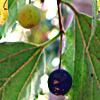The European Hackberry is a large deciduous tree, which reaches a height of up to 20 meters. It is not clear whether it grows wild in Israel, or whether all the individuals in Israel were planted or escaped from cultivation. It has distinct asymmetrical leaves, with the apex tilted to one side and the midvein divides the leaf it into two unequal parts. The leaf margin is dentate, with a length of 10 cm. The lower part is covered with hairs (hirsute). Its relative Ulmus (elm) has a similar asymmetrical leaf, but differs in its fruit: the elm has a compressed samara whereas Celtis australis has a spherical fruit, which is black when ripe, with a large stone in the center. The pulp of the fruit is edible.
Celtis australis blooms in the spring. The green-yellowish flowers are small. Its wood is used for ornamental objects, furniture, tool handles and saddles. The bark is smooth, and light gray in color.
Celtis australis grows mainly in the northern part of Israel. Its global distribution is across the Mediterranean countries. The genus contains 80 species, most of which grow in the Northern Hemisphere.
Written by Mike Livne






